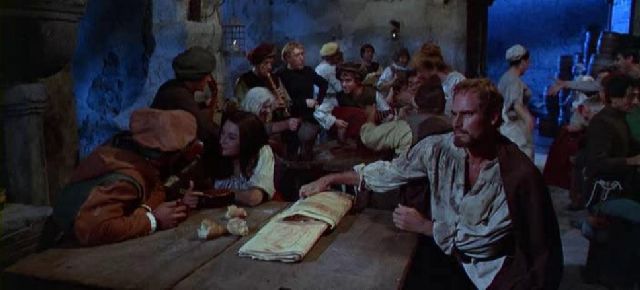The Agony and the Ecstasy (1965) 
“A raging era of titans, popes and princes… of conspiracy and conflict… of turmoil and transgressions… of a man among men… of magnificence!”

Director: Carol Reed
Cast: Charlton Heston, Rex Harrison, Diane Cilento
Synopsis: The biographical story of Michelangelo’s troubles while painting the Sistine Chapel at the urging of Pope Julius II.
‘When will you make an end?’ demands Pope Julius II (Rex Harrison) of Michelangelo (Charlton Heston), reluctant creator of the ceiling fresco on the Sistine Chapel as he ceaselessly toils on makeshift scaffolds. And always he receives the same response from the exhausted artist: ‘When I am finished.’ It’s a running joke in an otherwise sombre epic which illustrates in a nutshell the clash between the pope’s impatience and the artist’s perfectionism.
The Agony and the Ecstasy is based on Irving Stone’s novel, and although it avoids many of the overblown pitfalls of the Hollywood epic, the contentious relationship between Michelangelo and the warrior pope is largely speculative fiction. Similarly, some aspects of the film support commonly held misconceptions such as the artist lying on his back to paint the ceiling (he actually painted while standing), and the scaffold towering from the floor when it was in reality a platform held in place by brackets in the walls.
Nevertheless, Philip Dunne’s screen adaptation of Stone’s novel provides a compelling insight into a mammoth undertaking that would have broken many men (it actually took 4 years to complete, a fact not mentioned in the film), and serves as a character study of two strong-minded, wilful men who repeatedly clash while in pursuit of the same objective. The vainglorious Pope Julius’s character acquires an air of nobility as the film approaches its conclusion which is noticeably absent in the early scenes, while Michelangelo’s doubts and weaknesses grow increasingly apparent as the story unfolds. Charlton Heston, giving one of his better performances, plays Michelangelo as a brooding man, consumed by his passion for artistic creation to the exclusion of romantic love offered by the patient Contessina de Medici (Diane Cilento), but he is overshadowed by Harrison in an admittedly showier role.
While the film is superior to the usual Hollywood epic, it isn’t entirely unaffected by tinsel town artifice. It was only a matter of time before some character said of Michelangelo something like, ‘It’s not blood that runs through his veins, but paint,’ and sure enough the Pope pipes up with what amounts to the kind of line you’d find in an amateur dramatics production. Likewise, the pope’s sudden revival on his deathbed is almost laughable, and really stands out as a moment of bad taste in a movie that is otherwise quite respectful towards its subject matter. The location photography, however, is simply stunning.
(Reviewed 20th March 2012)
httpv://www.youtube.com/watch?v=0j8w1c0HyOE
